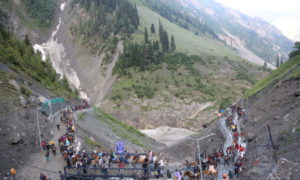The ongoing Amarnath yatra will be the “biggest”, as around one million pilgrims from different parts of India are expected to take part in it.
Darishka couldn’t conceal her happiness as she arrived in Kashmir in the first batch of around 4,000 Amarnath yatris.
The young woman was cooling her heels at Pahalgam base camp for the holy mount.
As the rush increased with time, she drifted into a meditative state — chanting mantras and singing devotional songs.
“We were desperately waiting for the yatra from the last two years,” Darishka said with a big smile. “Everyone is quite happy. I came here with my family and we’ve decided to walk up to our destination. We don’t want to miss any moment of it.”

Heavy troop deployment along the route to Amarnath. [FPK Photo/Masroor Ashraf.]
Chanting “Bam Bam Bole”, the Hindu pilgrims arrived on the annual Amarnath Yatra in Kashmir after two-years of pandemic pause.
The ongoing yatra will be the “biggest”, as around million pilgrims from different parts of India are expected to take part in it.
Some 80,000 armed forces have been additionally deployed along the yatra routes. There’re two base camps from where these pilgrims leave for the cave visit—Pahalgam and Sonamarg.

Yatris waiting for a cab. [FPK Photo/Masroor Ashraf.]
Amarnath Yatra is an annual pilgrimage in which Hindus visit the cave of the deity—Shiva—located in Lidder valley, Anantnag Kashmir. The temple is deep inside the Himalayas and nestled some 3888 meters above sea level.
Last yatra was held in 2019 before suspended in the run-up to the abrogation of Article 370. For the subsequent two years, due to Covid-19, the yatra couldn’t take place.

Yatris chanting mantras while leaving Pahalgam base camp. [FPK Photo/Masroor Ashraf.]
Apart from manning routes and ridges, the armed forces are hawking highways and hills to “counter any threat”.
Plus, the Amarnath Shrine Board has made it mandatory to have a Radio-Frequency Identification (RFID) tag for the safety of pilgrims.
“But not every pilgrim is RFID-tagged,” said Vijay Kumar, a yatri from Gujarat. “We were allowed to travel from Bhagwati Nagar, Jammu, without RFID tag but in Pahalgam we were barred from the travel without it. If the Shrine Board has decided to allow 20,000 yatris for the daily darshan, then there should’ve been proper arrangements on ground for it.”

Army lining the yatris in a queue to maintain discipline. [FPK Photo/Masroor Ashraf.]
Amid discontentment, the delight of the yatris was telling. Uday Kumar, who came with 55 devotees from Hoshiarpur, Punjab after six years, was excited to be the part of the first pilgrimage post the pandemic.
“We’re very happy to be the part of yatra, but mismanagement is creating a lot of inconvenience,” Kumar said. “The attempt should’ve been to make it convenient process rather than a security exercise.”

Yatris move towards the main checkpoint where their documents get a final check. [FPK Photo/Masroor Ashraf.]
But Kashmiris who’ve been traditionally part of the yatra are once again living up to their name.
At Chandanwari, some of them have set up their stalls — selling handmade hiking sticks and providing ponies to make the journey of yatris smooth.
“We always provide best services to make the yatra an easy journey for our Hindu brothers and sisters,” said Tawseef Syed, a local horseman. “We’re doing this wholeheartedly.”

Horsemen waiting to ferry yatris to the cave. [FPK Photo/Masroor Ashraf.]
Amid the ongoing yatra, the spike in covid cases has become a major concern. The number of new cases has increased by 18 percent in the last week, with more than 4.1 million cases reported globally, according to the World Health Organisation.
In India, cases have increased by 78 per cent from the average two weeks ago but there was no sign of Covid protocols being followed during the yatra.
“There’s hardly any fear of Covid now,” said Darishka, while preparing to scale the cave. “The resumption of this holy pilgrimage is itself a sign of good times ahead of us.”










